
 |
|||
| Roman Verostko |
|
Notes on the original paper: In 1986 my wife Alice and I began searching for a term to describe the art-making process whereby works are generated by the artist's own coded procedures. In 1987 we settled on the term epigenetic as a specific descriptor of the algorithmic procedures in my work. The following year (1988) I presented this paper identifying the biological analogues for art works executed with algorithms created by artists. Over the years the software described here has been modified to allow more user controls and options. As time goes on I find myself more and more working on specific parameters to control outcomes. Nevertheless, the procedures I follow remain essentially the same - all form generation is achieved with original coded procedure. Following a careful reading of this paper, in the year 2002, I still believe it correctly identifies the nature of the procedure employed by artists who write original code for generating art forms. Individual artists, such as my colleagues Jean Pierre Hebert, Harold Cohen, and Manfred Mohr employ original coded procedures for generating artistic form. Their algorithms may also be compared to genotype and the procedure properly viewed as analogous to epigenesis. Those who have witnessed the unfolding of an algorithmic drawing understand more easily how the analogy holds true. Often, while watching Jean Pierre's work unfold in his studio, I experienced the process of his coded procedure "growing" a form! epigenesis, indeed! The original paper, addressing the procedure, was presented with about 160 slides. Some of the original slides have either been lost or never transferred into a raster format. Recently I added more illustrations with documentary notes for this internet version. Even so this version still lacks some of the slide types that were in the Utrecht presentation (1988). I hope, eventually, to locate and digitize some of those images and add them to my web site. Roman Verostko, Minneapolis, April 2002 This paper, presented at the First International Symposium on Electronic Art (FISEA, Utrecht, 1988) was published in Leonardo, 23:1,1990, pp.17-23 by the International Society of the Arts, Sciences and Technology (ISAST). This version, taken from the original file copy, includes several annotations and may differ slightly from the publisher's edited version. This paper is published in Leonardo, Vol. 23, No. 1, pp. 17-23, 1990. Permission to reproduce this paper is kindly granted by the author and Leonardo. For information on Leonardo see their home page at:
|
EPIGENETIC PAINTING Software As Genotype
|
|||||||||||||||||||||||||||||||||||||||||||||||||||||
 |
Fig 1. New City, 1966 ©
2 ft by 2 ft, Acrylic paint, crayon and gesso on wood. Painting by hand from the 1960's includes spontaneous gesture and highly contolled rectangular element in the same visual field. |
For over 20 years my paintings played with a visual dialectic between control and uncontrol. The paintings presented visual opposites in a kind of dialectic between "order" and chaos. The first works with this dialectic were executed between 1964 and 1968 on wooden panels with heavy grained wood, (Figure 1), (Figure 2), (Figure 5).
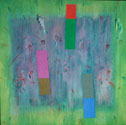 |
Fig 2. The New City, 1968 ©
4 ft by 4 ft, Acrylic paint, crayon and gesso on wood. Painted by hand. Use of "control" and "uncontrol" in the same visual field |
In making these works the first phase was to delineate carefully one or several rectangular fields with variable spacing creating visual movement relative to the overall field. These rectangles were carefully filled with a heavy synthetic impasto making a slightly raised rectangular relief on the panel.
Next, in very intense sessions, I would mark the surface with spontaneous gestures, sometimes with brushes , sometimes with crayons or pencils. The gestural marks were imbedded in layers of colored stains that drew out the grain of the wood.
The gestural aspects of the work represented that aspect of human experience that might come from "uncontrol" - such as a feeling or an impulse. The dominant rule was that the marks had to be entirely spontaneous without any conscious editing. For several years I had worked through hundreds of gestural works in an effort to make irrational marks (Figure 3), (Figure 4).
Through this process, in a kind of spiritual quest - one has to empty the self of "thinking", be entirely present to the moment, and strive to be one with one's world. To be one with the brush, the crayon, the panel, the universe - in a free flowing gesture was indeed the goal. Being most "free" was also being most "joined". A gesture free of rigid aesthetic conceptions harmonizes easily with natural forces. This can be seen in the splash of paint that yields to unseen forces like gravity. It reveals the forces to which it yields and to which it is joined. Can this be achieved with software?
 |
Fig. 3,
1964 pencil, crayon & wash with ink. 30" by 22" © |
 |
Fig. 4 1964.
pencil, crayon & wash with ink. 30" by 22" © |
Above: Exploring internal states via automatic gestures and marks. By hand.
In the final stages of the work the rectangular areas were painted according to another set of rules - but never absolutely so. Each rectangle was painted with a value and a color that gave it a visual push or pull slightly forward or slightly receding from the predominant picture plane (Figure 2) , (Figure 5). Simultaneously the placement was intended to lend precarious but effective balance between all the lateral inclinations. The push or pull, advancing or receding, and the lateral movements, were a visual means of keeping a tension (opposition) between the rectangles and yet maintaining an equilibrium in the overall painting.
 |
Fig. 5 New City 2, 1966
3 ft by 3 ft, Acrylic paint, crayon and gesso on wood. Painted by hand. Use of "control" and "uncontrol" in the same visual field |
This approach was influenced by Piet Mondrian's concept of "dynamic equilibrium". In reference to his own work before World War I, he wrote of how he perceived nature in his quest for unity: "Impressed by the vastness of nature, I was trying to express its expansion, rest, and unity. .. . To create unity, art has to follow not nature's aspect but what nature really is. Appearing in oppositions, nature is unity ". [1]
Mondrian's perception that one must follow what nature really is and not her 'aspect' means that he perceived a deeper unity than lay on surface appearances. His search for that deeper force led him to see that life springs from the tension of opposites and that he could make art that reflected this dynamic. For him this dynamic had a profound spiritual meaning which he could manifest in works which obtained dynamic equilibrium. The ideas he developed for achieving a visual expression of this dynamic equilibrium could be called his "art concept".
Mondrian's way of thinking about art, along with that of Malevich and Kandinsky influenced me in seeking and formulating my own art concept. Eventually I came to work with the extremes of visual opposites within one and the same painting field. These elements were shaped by the extremes of control and uncontrol.
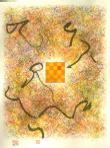 |
Fig. 6 Pathway 1, 1988
3 ft by 2 ft on paper. Algorithmic pen and brush plotted painting. |
The present works represent apparent polarities of human experience - the rational and the irrational, body and spirit, life and death, heaven and earth. Both in the paintings and in human experience we find that radical polarity generally implies its opposite - dark implies light or conversely light implies dark. (Figure 6)
The works, as a visual dialectic between control and uncontrol, embody an idea about how to make art. They also represent the spiritual struggle of life itself. One learns that peace and unity lie in the balance between reason and feeling - between all those interior forces that push and pull us in opposite directions. They seem related to traditional oriental wisdom rooted and imaged in the yin/yang, woman/man, moon/sun, soft/hard, earth/heaven.
In order to translate an art concept into software one must first describe the specific art making procedures. This is achieved by thinking through each step. For example if the procedure begins with drawing a line then the basis for all the line drawing procedures must be identified. This includes the basis for the starting point, the color decisions, the quality and character of the line, and its changing angles, flow, and length. Once these procedures and relationships are understood they can be translated into software. The software code is a formal system equivalent to the art concept, an isomorphism in a computer language.
 |
Example
of an "all-over" scribble procedure as a form of computer
automatism. 1987, 4" by 6". a small pen plotted drawing. |
A similar isomorphism lies at the heart of D. Hofstadter's book Godel, Escher, Bach: An Eternal Golden Braid. In discussing how one can view a formal system both typographically and arithmetically, he notes that
"typographical rules for manipulating numerals are actually arithmetic rules for operating on numbers."
This simple observation is the heart of Godel's method, and it will have an absolutely shattering effect . It tells us that once we have a Godel-numbering for any formal system, we can straight-away form a set of arithmetical rules which complete the Godel isomorphism. The upshot is that we can transfer the study of any formal system - in fact the study of all formal systems - into number theory". [2]
To reiterate, if we can describe the procedures for expressing our "art concept" then we can code those procedures and work with them arithmetically. Suppose then that we are able to describe an "art concept" rather comprehensively. The description of an art concept is essentially an outline of the decision system that governs the art-making procedures. We outline why, how, and where we prefer to draw lines or paint areas. We outline the basis for how we scale relationships, choose colors and space the pictorial elements within the work. We identify the conditions of acceptable and unacceptable combinations of shape, scale, form and color. When these steps have been done in a thoroughly systematic way, we have described a formal system that can then be coded.
While Hodos embodies the essential art concepts with which I work the process is still rather primitive. There are tested routines planned for the existing program and more to be developed. The process never ends. One reaches a plateau which provides the viewpoint from which one sets up operations to attain the next plateau. Through this dialectic the original art concept undergoes transformation and the software evolves to the next stage.
Let us consider how this works specifically for the most obvious "control" elements, the rectangular shapes. In the wood panels I created in the 1960's the rectangular shapes do not overlap, they are never closer or further apart than certain distances relative to the over-all space. They are painted with opposing hues but with intensities and values (shades) just close enough to neutral to keep the balance precarious. Further analysis would show other subtle relations as part of the overall formal system. All of this can be coded so that once the first move is made the procedure grows a set of rectangular shapes based on the artist's rules.
 |
Example of a 1987 scribble with rectangular areas selected and executed algorithmically. Each procedure made "uncontrol" decisions (random selections) within "controlling" parameters. Pen plotted drawing, 1987. |
The automated procedures for identifying areas use both control (by fixing parameters) and uncontrol (by selecting randomly within the parameters). For example, a 'starting point' routine may need several pieces of controller information such as preferred and forbidden starting areas. If one thinks of the pseudo-randomizing routine as 'tossing dice' , then the procedure in plain English might read as follows: "Find a valid starting point by tossing dice weighted for not more than a 25% deviation from the center of a preferred region.
The artist, in the refining process, usually reviews scores of possibilities before making a software decision. By observation the artist learns to adjust the routine and the data to achieve the desired formal effects. After some experience the artist might see how he can modify the algorithm to introduce variable scaling relationships that were not evident in earlier work. This feedback process provides a way for both refinement and growth.
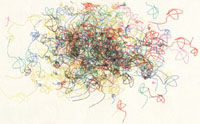 |
Epigenetic drawing that employs randomizing routines within controlled parameters. Each pen stroke is generated from a single set of control points. Distributions are keyed to the same set of control points yielding a self-similarity that permeates the whole. |
We can do the same with every element that the "art concept" requires for building the work. For example, a scribble routine is coded to rotate randomly within certain parameters. The rotation parameters have been determined by experience with what has worked and what hasn't. Still the variables are changeable and are revised from time to time. Sometimes the slightest change of a routine opens up new vistas. The "uncontrol" elements that course through the program may be better understood if we outline their sources and how they entered the work.
In the initial phases of my computer work I sought to write a simple program just to sample the computer as a medium, that is, just to get the computing process to generate the work. The simplest way would be to mime automatic art. Step one was to make a scribble loop that would unveil the inner workings of the computer, similar to the way a Paul Klee doodle revealed the inner life of Paul Klee. That venture was not very successful but it yielded insight into computerized automatic processes. Such work is related to a genre of artistic activity which began early in this century.
 |
Photo from a sequence in the Magic Hand of Chance (CGI monitor & PC, ca. 1982). Drawings were generated in real time and underwent continuous transformation. Each routine generated its own titles. This "ghoul sequence" will never re-appear as each sequence is seeded from a moment in real time. |
 |
Titles were generated as a separate frame preceding the sequence for each routine. |
Automatic art, tachism, and abstract expressionism are terms loosely associated with the idea that one can express something of one's psychic life which lies under, above or beyond conscious life by working in a dream-like or trance-like state. Such drawing, similar to doodling in an absent minded state, was practiced by the surrealists in the 1920's and even earlier by some of the dadaists.
Both spontaneous gestural drawing and the dadaist non-sensical juxtaposition of words employ techniques which step outside of rational procedure. Non-sense sounds, like non-sense drawing were used in the "dada" soirees to shock those who felt complacent with the power of reason. Some felt that, if it was reasonable to kill and be killed in the trenches, then perhaps "non-sense" should reign rather than reason. After all, some concluded, only political "reasoning" made "sense" out of the war.
Out of that artistic milieu came artists who learned to enter the frontiers of their inner world; through dreams and free associations both artists and poets opened a new artistic frontier. My first computer efforts were simple routines to get the computer to mime some of the artistic forays that took place early in this century.
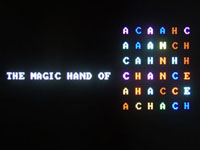 |
The Magic Hand of Chance (1982-85). The title sequence randomizes the letters A,C,E,H, and N in a 6 by 6 matrix and settles down when the sequence C H A N C E is achieved in the 4th row. |
Eventually I came to focus on routines which mimed automatism with lines, shapes, colors, words, syllables, and even sound. I filled literally scores of disks with draw routines, lexicons, and poet routines for writing free forms, haiku and title lines.
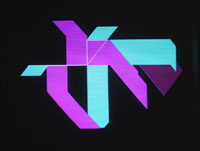 |
 |
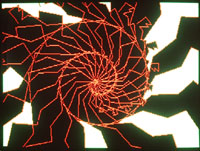 |
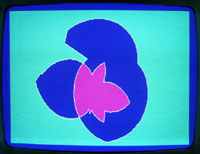 |
Above: Frames from routines in the Magic Hand of Chance (1982-85). Frames changed continuously with a new title for each improvisation proceding in real time without repeating itself. Titles and improvisations were always "one of a kind" originals. Raster screens in CGI graphics were limited to 200 by 320 pixels (medium) or 200 by 640 pixels (high). The pen plotter allowed 1,000 increments to the inch and therefore provided the ideal graphics peripheral in the 1980's.
My first exhibition piece, "The Magic Hand of Chance", was exhibited on a 25 inch monitor cabled to a personal computer. The program worked in real time generating a series of six visual improvisations which were displayed in dynamic sequence on the monitor. All words and images were generated in real time and each sequence was always an original improvisation. These works with their non-repetitive improvisations, evoked the kinds of surprises that we get from free association.
The routines included The Sayings of Omphalos, the Greek word omphalos (navel) being the name of the computer I used at that time. The title alludes to the sayings of Mao Ze-Dong. They have the form of Wisdom Literature but are actually playful nonsense pieces. An occasional juxtaposition of terms may shock us, as in free association, altering our viewpoint. Here is an example of the sayings (Appendix A has several more). Omphalos on Prank: / The weak prank / regularly pricks; / Ponder blindly / before prank strains.
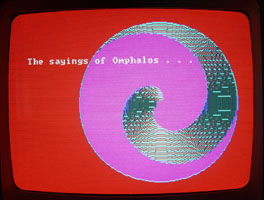 |
Sayings of Omphalos title screen, one of several routines in the Magic Hand of Chance (1982-85). Title image on a CGI monitor. Exhibited in the MCAD faculty show in 1985 on a 25" Sony XBR cabled to a PC. |
The program also has self titling routines which generate original improvisational titles for each sequence. Some examples: "Instantly Frayed Whimsy"; "Lunkhead Thrills Iceman"; "Your Joyous Alarm"; "Bad Egg Brews.
The most nonsensical of these routines is Jabberwock, which is part of a larger program that was later abandoned. The program titles a subject of discourse and then proceeds to write a paper. Here is some Jabberwock written on September 1, 1988. Jabberwock titled its subject Enkaom Suxe Ilib. The first paragraph reads: "Schusca umopoh. Efet enkaom ku cuile oteoj yucou pnuibi suxe cu suxe. Ku ilib eey okoy oteoj uiyaurd autifib sciefio ilmedth. Qithi soraihio bu ghiahu sorio suxe. Sonua oray ultap enkaom ruweko suxe ku unuedum eg. Suxe ghiahu oden proveo ioyus ulmeuk".
Jabberwock and the Magic Hand of Chance provided the kind of logic from which the painting program grew. Eventually I became interested in "hard copy" and began to write software for building pictorial elements with lines and brush-strokes.
Lately this work has been most effectively realized in the program Hodos which embodies the art concept described earlier. With a personal computer driving a 14-pen plotter, Hodos makes paintings which have a family resemblance to my earlier work.
 |
Fig. 7 Pathway Series, 1988 ©
40" by 24", Algorithmic pen plot on paper. By 1988 the software had achieved subtle painterly effects. |
An outside observer, without knowing the techniques employed, might view them as a natural evolution in the hand of the artist. The automated techniques are so transparent that the viewer sees the artist's hand in individual lines and paint strokes. But the artist's algorithms work in lieu of the artist and the plotter's arm works in lieu of the artist's hand. This frees the artist to concentrate creative energy on the next level of the dialectic.
Hodos, the title for the software, means 'path' or road in Greek. Note that Meta-hodos is the root for "method". The algorithms in Hodos describe "paths" which is the "method" for achieving the painting. Hodos as the "path" or the "way" is our Western equivalent of the Chinese term Dao (Tao), a key concept in ancient Chinese wisdom.
 |
Fig. 8 Classic Chinese Calligraphy 'Shufa'
'Cao shu' (grass writing) style, by Zhang Xu of the Tang period. Text reads "yan xia" meaning "under the cliff". |
Some of the most recent works are built with simple brush strokes derived from a range of about 8 to 16 control points. Several of these works, titled Woo Way have some resemblance to Chinese traditional calligraphy. Figure 8 shows a classic example of cao shu 'grass writing' by Zhang Xu of the Tang period, The text reads yan cia 'under the cliff'. Such calligraphy , still taught and practiced in today's academies, was practiced by the literati.
The Hodos brush strokes represent an effort to achieve the fresh qualities of spontaneity and sureness of stroke. Woo Way is word-play, an allusion to the Chinese traditional wisdom of Wu Wei which literally means "do nothing" and suggests letting nature take its course. It implies that one should not interfere with the natural course but rather flow with the way. The computer gestures do not show the characters for Wu Wei, but perhaps the process is a form of Wu Wei.
 |
Fig. 9 Lung Shan II, 1990 ©
24" by 72" Algorithmic pen and brush painting |
The strokes follow whatever path the chaotic system makes. Whatever way unfolds in the context is just fine. A simple routine, similar to tossing dice, initiates the path. From then on the process has a remarkable life of its own following its own unique way. Figure 12 is a brush stroke sample demonstrating the character of one such "pathway". Lungshan II (above) and Carnival (below) show how such strokes have been generated by Hodos in works that include advanced forms of control and uncontrol.
 |
Fig. 10 Pathway Series, Carnival, 1989 ©
2 ft by 3 ft algorithmic pen and brush plotted painting |
While all the routines are automated, the default settings and data files are usually adjusted by the artist at startup time. For a recent show, over 40 works were generated with the same code (Figure 10), The works bear a family resemblance to each other and to earlier works, yet each one is original. These and other unique features of this medium raise a multitude of questions we did not have before. We will look at these following our discussion of hardware.
Thus far we have been discussing how an "art concept" can be coded when its formal system can be described. However, software in itself is something like a musical score. While all the musical ideas may be embodied in the score we still can't experience the music unless it is played on an instrument. The computer can be cabled to many different kinds of peripherals such as a printer, a plotter, a synthesizer, and a telephone.
Usually I review how the code is working through crude simulations on a monitor. But the pixels on the monitor have only a token relationship to paintings. While many artists get hard copy by photographing the monitor I prefer to work with a plotter. A plotter is a drawing machine which can execute drawing instructions sent to it by a computer. Such machines are commonly used for architectural and engineering drawing.
Hodos is written to drive a pen plotter which has 14 pen stalls arranged in two banks with 7 pens in each bank [Note 3]. Permanent inks are mixed for refillable pen cartridges and arranged on the plotter in a classical palette going from warm to cool colors. The program follows rules about where to look for the pens but the defaults can be altered by the artist at start up.
Work is executed on rag papers with a moderate tooth. A standard single frame size is 21.5 inches by 32 inches on a 24 by 36 inch paper. Two frames lengthwise easily achieves a six foot work.
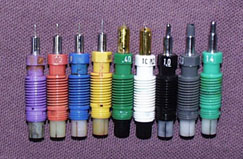 |
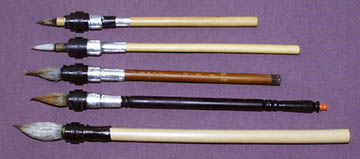 |
| Pen points range from .18 to .75 or more. | Oriental brushes with ferules adapted to fit the pen plotter. |
The technical pens range in size from "2" to "000" (.50 to .25) with refillable cartridges I have also designed suitable sleeves for a number of Chinese brushes for mounting on the drawing arm of the plotter. Special "paint brush" routines are integrated in the program for those paintings which require them. All the pen routines are automated so the complete painting may be made without the artist being present. However, although all brush strokes are automatically generated by the software, the mechanical limitation requires an assistant to hand the brush to the plotter on demand. (Note: In 1995 the adaptation of self-inking Sumi brushes made continuous brush scripting possible).
 |
Fig. 11 Pen & Brush plotted work in
process. Plotter executing first brush stroke, December 12, 1987. |
I felt somewhat foolish introducing this routine. I had spent long hours developing a routine to make the drawing machine paint with a brush. It seemed clumsy and almost pointless at first. But through trial and error with the brush mounts, the software, the inks, and the paper, a vast untapped potential emerged. Figure 7 shows the first use of the paint-brush routine in a finished work.
With the software driven stroke there is a sureness and directness that is almost exhilarating. The software knows for sure where beginnings and endings are - precisely. It remembers the stroke and can improvise with the same stroke in a scalar fashion, and do so without failure. This latter ability, which I have only begun to explore, promises to be a rich ground for development.
 |
Fig. 12
Brush stroke made with Hodos.
Note the lower right pen stroke, a scaled down version of the brush stroke, illustrates the potential of the algorithm. |
Figure 3 shows a full size stroke with a scaled down version of the same information drawn with a pen. This software generated version of a spontaneous stroke was created entirely by the artist's software. Notice the spontaneous quality of the stroke and how it drags off softly in relation to the tooth of the paper on the upper left portion. This stroke has many of the same qualities that are valued in Chinese Shufa (Figure 12). The stroke shows movement, response to paper texture, dry brush effects, and sureness.
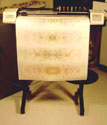 |
Houston
Instruments multi-pen plotter, DMP 52 (1989)
Image shows pen plotter with a 7 pen carriage, one of two carriages providing a 14 pen capability. This was the plotter used for all the work shown with the original Utrecht paper. Later plotters reduced the carriages to 8 pens. By the mid-90's my work rarely went beyond a 5 color palette. |
Hardware that fits the artist's goal is as essential as the software - and it is central to the development of that software. The unique qualities associated with a particular hardware provides an opportunity to enhance the final form. The plotter lends itself especially well to several important ways:
Hodos introduces art-making procedures of a different order than traditional procedures. The closest analogy might be the score for a musical composition. Both the musical score and software art provide instructions for the creation of an artistic form. The traditional musical score, however, however, requires skilled players and provides the rules for playing only the same piece each time. Hodos requires no skilled players and can improvise an original work every time (See Note 4 for a 1995 change of view on this point).
A process which can improvise on an artist's own form ideas without the artist being present extends the power of the original art concept. For example, a colleague from a university some thousand miles away suggested sending my software as a "visiting artist" next semester.
What are the implications? Traditional technologies require that the artist must direct even the simplest improvisation on a print or photograph. The change in exposure, color or light must either be made or directed by the artist. In software art some of the artist's sensibilities about how to make improvisations are coded. This code extends the artist's ability to improvise or preview improvisational possibilities without appparent limits. Such power of improvisation provides the artist with an awesome leverage for exploring form-making ideas.
A Biological Analogue
The process for making art with a "personal expert system" has a strong resemblance to the biological process of epigenesis. The epigenesis of organisms is the process whereby a mature life form grows from its seed. In this analogy the software may be viewed as genotype or the seed that contains all the information necessary for growing the mature form. A brief review of the biological terms may help clarify this analogy.
In genetics the term "epigenesis" is used to describe the process whereby the "phenotype" (a physical organism) grows (unfolds) from a genotype (DNA). The analogous procedure for the paintings suggests that: Hodos, the software, may be viewed as "genotype", the painting as "phenotype", and the process as epigenesis [Note 5]. Software art has adequate information about "how to grow the painting" through a series of recursive graphic routines; each unfolded offspring is a variant of its predecessor. The analogy stops here as these "offspring" cannot beget the next generation. However, they do point the way for the artist in designing the next generation of software. (Note: Since the original draft of this paper the genetic algorithm has been used by Karl Simms and other artists to grow generations of form)
Art Making Systems
In summary, a new order of art making systems has been emerging. In the present stage the feed-back from the program helps the artist develop the next stage of software. The evolving program helps create itself. This is no different from using a compiler to design a better compiler. There are plateaus of sophistication. The evolving software is the new art and it can be viewed as analogous to genetic code, genotype.
The software also has the potential for hybridization. Let us assume that we could code an art idea of Wassily Kandinsky and a musical idea by M. P. Mussorgsky. We might then build a hybrid "Kandinsky-Mussorgsky" code. One could add audio and visual drivers for all or part of the code, as desired. Eventually one could pair this art concept with another. Each frontier opens a new frontier.
Within the next decade or so advances in high-level software will make it possible for more artists to easily build their own personal expert systems. Families of improvisational works will grow by generations. Familial form traits, like gene characteristics, will reside in the high level expert systems that artists use to make their own expert systems. Some inherited familial features will pop up in some works and not in others as artists learn how to get their own form preferences to prevail.
In a very uncanny way software appears to have a life of its own. The artist's role is to humanize it - give it the form and structure to serve the quality of our art and of our life.
1.P. Mondrian, "Towards the True Vision of Reality", in d.m.a. 2. Plastic Art and Pure Plastic Art, p.15, (N.Y., 1951).
2.D.Hofstadter, Godel, Escher, Bach: An Eternal Golden Braid (Vintage, N.Y. 1980), p.264.
3. The 14 pen plotters were abandoned by the manufacturer and the multi-pen standard became 8 pens. All of my active plotters have 8 pen carriages.
4. Since writing this passage it becomes increasingly clear that the quality of output is related to "virtuoso" skills in executing the work. When Hodos is used for a serial edition then collaboration with a master printmaker as "virtuoso" is preferred.
5. C.H. Waddington uses the term epigenetic landscape to illustrate his theory on evolving patterns in organic life (The Strategy of Genes, London, George Allen and Unwin, 1957). The illustration and its implications have been discussed by P.T. Saunder in his article on the "Evolution of Form and Pattern" (Leonardo) 22,1, 1989). The discussion reinforces the notion that a family of forms generated by the same algorithm follows a process very similar to epigenesis.
6. In the decade following the original paper, 1988-1998, the software evolved with more "user" controls allowing me more latitude in setting parameters for any given family of forms. While improvisations can be executed by another person from parameters that I have setup, I prefer to monitor each step and make changes as the work proceeds. A studio virtuosity with the pens, inks, papers, and plotting speeds make a difference in the quality of the finished work. Recently I take over much more control as the work proceeds. In effect my personal expert system has become a companion with which I improvise but it is much less expert than I originally envisioned!
Sample texts from the Sayings of Omphalos recorded for the original article in Leonardo. Each "saying" is an original text composed in real time by Hodos. The "Magic Hand of Chance", presented on a 25" Sony XBR monitor cabled to a PC, ran non-stop for one month during an exhibition at the Minneapolis College of Art and Design in 1985. The "sayings", were randomly called within a series of "Magic Hand" routines, with a parameter setting that guaranteed 5 calls for each complete cycle.
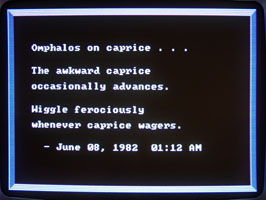 |
Omphalos on Caprice. Example of the presentation format for one of the sayings. The sayings were always original and generated in real time. Background and text colors were varied. The sayings were date stamped and could be saved and printed as a graphic on a dot matrix printer. |
Omphalos on Age: The tattered age / opportunely wobbles. Plow over / whenever age chafes.
Omphalos on Sheik: The rapid sheik / rarely abdicates. Cook wittily / after sheik dissolves.
Omphalos on Road: The road shoves warrior / rapturously. Seldom awful road / pleases cryptogram.
Omphalos on Hole: The noble hole / consistently raids. Cook skillfully / even if hole caresses.
Omphalos on Virtue: The lifeless virtue / inopportunely breeds. Manage ably whenever / virtue scolds.